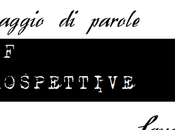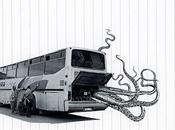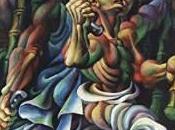- Da Komikazen 2011: il fumetto politico di Seth Tobocman
- Komikazen 2011: Seth Tobocman and political comics. ENGLISH VERSION
- KOMIKAZEN 2011 – Amir and Khalil, an interview ENGLISH VERSION
- KOMIKAZEN 2011 – I figli perduti dell’Iran: intervista a Amir e Khalil
 > LoSpazioBianco" />> LoSpazioBianco" />> LoSpazioBianco" />> LoSpazioBianco" height="85" width="470" alt="KOMIKAZEN 2011 Amir and Khalil, an interview ENGLISH VERSION >> LoSpazioBianco" class="aligncenter size-full wp-image-40388" />
> LoSpazioBianco" />> LoSpazioBianco" />> LoSpazioBianco" />> LoSpazioBianco" height="85" width="470" alt="KOMIKAZEN 2011 Amir and Khalil, an interview ENGLISH VERSION >> LoSpazioBianco" class="aligncenter size-full wp-image-40388" />
Hello Amir and Khalil is the first time in my life that I’m interviewing persons covered by a pseudonym, can you explain why you need to hide your identity?
Amir: Khalil and I wanted to have the freedom to create and publish without having to censor ourselves. And we did not want to cause unnecessary headaches for our friends, family, publisher and others. So we decided to err on the side of caution.But what matters a lot more than our identity is solidarity with the political prisoners inside Evin prison. They are the ones who are in harm’s way. So are Iran’s opposition leaders and their wives. Let’s worry about them.
How did the idea of Zahra’s Paradise and how you worked to develop it together?
Amir: Khalil and I got acquainted when I was still a journalist, and we dissocovered that we had an old mutual friend. Later, when I visited his studio, I was fascinated by his artwork : his sculpture, his ceramics, his drawings all touched me very deeply. I immediately felt inspired in his presence and felt a deep human connection of trust and gratitude, as if together we’d rediscovered a place and time long since gone. It didn’t take us long to become co-conspirators.
The idea of our graphic novel sprang from the real-life story of a Tehran mother who lost her son during a huge protest demonstration following the official election results in June 2009. But instead of making Zahra’s Paradise the real story of this woman and her son, we chose to make a fictionalized version of this story, to avoid jeopardising this woman and her family and also to be freer to dramatize this tale more freely.
The style of your comic reminded me Will Eisner, and more generally the 60s? You have been inspired by him or someone else?
Khalil: It’s always flattering for me to hear that Will Eisner has somehow seeped into my graphic style, because I dearly love his work, both in terms of the drawings and the narrative power of his plots. However, I’m also always surprised to hear that, as this similarity is quite unconscious on my part: Maybe we just have natural affinities of style? I never think of Eisner’s the Spirit when I’m drawing, but it is one of my many favorite comic strips, indeed. There are many other great artists who have influenced me much more consciously (Hugo Pratt, Jean Giraud, Hergé, André Franquin, etc…) but my style is very different than theirs and so it never gets compared to theirs. It’s interesting that even though I grew up with European comic strip as a child, it is American cartoonists that I get compared to, after living in the USA all my ***** life. My American work tools and American ink must have given my work an American accent…? But I’m also very deeply influenced by North African comic strip, painting and Persian miniature drawing.
I was stunned by the beauty of some large tables that take a full page, who did the idea of this visual solution?
Khalil: Thank you. Those graphic layouts were dictated to me by the drama of the story we tell in Zahra’s Paradise. I felt the need to break out of the usual boxes and frames to convey the profound and dizzying feelings that the situation in Iran inspires in me. Amir was so good at providing a profusion of journalistic details to vividly describe what goes on there, and it was my special mission to try to arrange all that wealth of information in a concise and dramatic fashion, and try to capture in visual terms the essence of the message in a memorable way.
Today comics are often used as a vehicle for autobiographies or stories with strong social themes, according to you is this the case? Why you have chosen the medium of the comic?
As a documentary film maker, I always find it really hard to capture a story through the camera. It’s complicated and very costly. With Khalil, everything became different. He’s able to ender a whole story with a simple pencil. A pencil! You want tehran ? Here’s Tehran! In mere seconds. No caméras, no hélicopter. In Khalil, I’ve found more than a collaborator: a way to transform imagination intoreality –throughhis artwork. Whatever it is that we imagine together, the end result almost always surpasses whatever we have dreamed up.
The web and social networks are the protagonists in your comic, what is the role of new technologies and social networks in the Arab world?
Amir: Iran has one of the most vibrant blogospheres in the world. By some counts, there are over 700,000 Persian language blogs, making Iran the third largest country of bloggers after the United States and China. Outside Iran, many of the top executives at Google, E-Bay, Yahoo and Oracle are Iranian, so there is no shortage of talent and resources when it comes to mastering technology. In fact, Iran has some of the best hackers in the world. They not only send shudders down the back of the Ayatollahs but when China threw its weight behind Ahmadinejad’s crackdown, they got hacked too. Tiananmentitis! During the protests, Iranians not only evaded capture using anti-censorship software, filters and such, but also used the Internet to expose the names, images and addresses of the thugs responsible for the atrocities in the streets of Tehran. One should also keep in mind the power of low-tech–good old xerox machines. A single cartoon or image can circulate all over Iran in a matter of minutes. And this virtual Iran extends all over the world–and includes many non-Iranians–so it breaks with the traditional paradigm of tribe and territory. There is no way that a single government can control it.
In you opinion the image that comes to the west of Iran and the Arab world in general is honest, real?
Khalil: It is an image that is vastly distorted and exaggerated. In every part of the world there are violent and vile, power-hungry cliques and individuals willing to sacrifice their own people and their country for the sake to their own personal ambitions. The Arab (and Iranian) world is no exception to that, unfortunately. But to reduce an entire culture to stereotypes of violence and hatred, as many western media do, is divisive and harmful. Amir and I have always been very sensitive to such negative stereotypes, and in our own small way, we strive to correct these distortions in our work. In Zahra’s Paradise, it is clearly a fascistic theocratic government that we denounce, not an entire people or faith.
Personally I think if I lived in Iran I would just run away like they did many artists (I think Marjane Satrapi). What has been your choice?
Amir: I left Iran when I was twelve, almost a year after the revolution of 1979. It was not my decision. After his return to Iran, Ayatollah Khomeini established revolutionary courts presided by a hanging judge named Ayatollah Khalkhali. That’s when the reign of terror started. The revolutionaries started executing thousands of people by labeling them as “mofsid fil-ard” (corruption on earth) and moharebs (enemies of God). Thousands of Iranians were killed with no evidence, no proof, simply by virtue of an accusation. It was a modern Inquisition–the state became an instrument for religious and political persecution. And that was the beginning of a massive exodus that continues to this day.
What message do you want to run and who speaks your comic?
Amir: Zahra’s Paradise is a collective work—a collage that has many authors and artists. And so the true medium is not our pen and paper, but the flesh and blood of the millions of people who risked life and limb to reclaim the past and future of Iran. They were the ones documenting the reality on the ground—not us. If we can see the reflection of their Iran, this glimmer of hope, courage and nobility that inspired an entire generation around the world, it is through the love, life and light captured and released through their cellphones. And those moments of protest were themselves the culmination of decades of resistance, and carried with them the dream, dignity and promise of generations going back to Iran’s constitutional revolution of 1906, if not earlier. So, as with any work of art, we recognize that Zahra’s Paradise derives its force and power from the price of a debt that binds us to the sacrifices of the living and the dead—the dissidents whose reflection is lost behind the walls of Evin prison.
Links:
Zahara’s Paradise, il blog: www.zahrasparadise.com
Komikazen 2011: www.komikazenfestival.org







